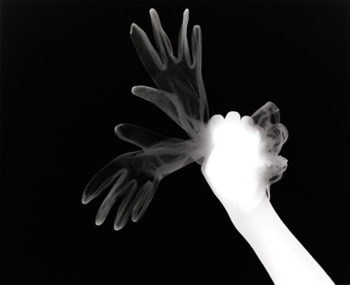Stolen Goods was a collaboration with artist Elizabeth Cohen, who I met in the Whitney Program in 1991.
We wanted to speak about the particular moment we were in as women involved in feminism and critical theory. We thought that instead of relying on the feminist critique of the 70s and 80s, which often involved critiques of power embedded in pleasure, we wanted to address feminine pleasure embedded in power, particularly in patriarchy, however illicit or ironic that pleasure might be. We began looking into histories of female pleasure, diagnosed as illness, and turned to Kleptomania, as a way to steal back representations of femininity, to replace a supposed female illness with pleasure.
Historically, there was a surge in female kleptomania in the 19th Century accompanying the rise of the department store. Women from all classes began stealing objects made to produce the masquerade of femininity. Often the kleptomaniac would compulsively steal and hoard a single type of object: sixty pairs of peach gloves, excessive amounts of lace or silk. Although this merchandise made them more valuable as sexual objects of exchange, the excessiveness imbedded in the act of repetitive stealing of feminine items proved to fulfill an erotic desire rather than simply a practical need. In fact, women have noted receiving autoerotic pleasure while shoplifting, particularly while stealing such tactile material as silk.
Through this rebellious act, women also apparently derived pleasure and a sense of power from getting what they wanted outside of the law in whose eyes they were largely invisible. Stealing was a way of making practical use of this invisibility. The crime was seen by society as a psychological disorder, and so women often were not prosecuted, but instead were sent to doctors for treatment.
The activity of the thief was an extreme and addictive response to capitalism and its lure of inciting an always unfulfilled desire. Like the female hysteric, the kleptomaniac took a socially prescribed norm of feminine sexuality to an extreme conclusion, perhaps self-consciously producing a parody. In the installation, we use strategies from surrealism and psychoanalysis, and suggest that the masquerade of femininity does not inhabit the realms of stealth and pathology, but can be strategically acted out from a position of strength and humor.
In the video,”The Dangling Carrot,” a woman who has attained an ideal proscription of femininity is peeling a carrot that never completely disappears. The dangling carrot is grabbed and peeled, acting out women’s traditional labor on this ridiculously disembodied phallic form.
The thimble, enlarged and transformed into a shot glass, loses its use value, and becomes a container for an addictive substance. Kleptomania was seen at the turn of the century as an addictive illness. The text inscribed on the thimble reads: “Just a thimbleful.” It is the lie of absent value – formerly a prosthetic tool for a hand in traditional women’s work – it now references the possession and consumption of an addictive substance in the negotiation of exchange value.
The raincoat makes reference to the female kleptomaniac and her counterpart – the exhibitionist. By looking at typical masculine and feminine perversions, the artifice of both becomes clear. Here we “see through” to the quantity of thimbles in her pockets. Once a tool she used to sew, this function has been taken over by the department store, and now the thimbles stand as a metonym for the manufacture and availability of this artifice of femininity. In this piece, the thimbles themselves become the desired objects, symbolically referencing the use value that the creation and wearing of this artifice can be put to.
The hair shoe doubles the codes of femininity by using long blond hair and a high healed shoe in an appropriation of two typical masculine fetishes. The silky blond hair references the autoerotic quality of silk that the historical kleptomaniac desired and stole. By presenting a “french braid”-like hair style at the toe, the woven hair of the female genitalia asserts itself in the place of the phallic substitute. Here absence becomes presence in autoerotic materiality.
A transparent wallet is filled with hand-tinted photographs of earrings, purses, garter belts, etc. This suggests the exchanging of images of representation. By placing images in a wallet, we suggest their use as money – as exchange value for a woman.
The photograms act as an index of the presence of the woman’s body in the act of reappropriation of these elements of the female masquerade.
By injecting our past representations with a projection of our pleasurable desires, we create representations that serve our own erotic investment.
Natalie Bookchin and Elizabeth Cohen (text from 1994)
